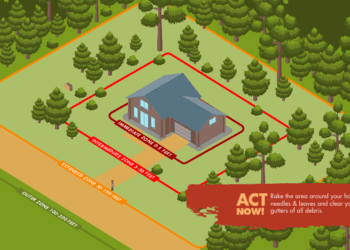When driving the canyon, know the physics behind aggressive tailgating and reaction time
By Paul Swenson EBS COLUMNIST
Here is a little experiment that you should try. Kind of a party trick too. Take a dollar bill, crease it down the middle lengthwise and ask a friend to catch it between their thumb and first finger when dropped from a vertical orientation. The only rule is that the catcher cannot move their fingers down with the bill to catch it. Most people will not be able to do this. How come?

Objects at the surface of the earth accelerate downward at 9.8 meters per second, per second. There are two “per seconds” because the units of acceleration tell us the rate at which the velocity of an object changes. Derived from Newton’s Laws, there is an equation that finds the time it takes for an object to fall a certain distance: time = the square root of (2 times distance, divided by 9.8). The dollar bill can fall 15.5 centimeters before it is outside the pinch of your friend’s fingers. This results in a time of t = .18 seconds. It normally takes an undistracted human about .2 seconds to react to a single stimulus. So, if you miss the dollar, you are normal.
Now try the experiment again using a second stimulus. Tell your friend the funniest joke you can think of and at some random time during the joke, drop the bill. It should be apparent that their reaction time is slower. Now have them type a text to you with their dominate hand, repeating the joke you are telling, and randomly drop the bill. With three stimuli, their reaction time really slows down. My guess is that while they are texting, they will not even see the bill being released.
Behind the wheel
Now apply what we just learned to driving in the Gallatin Canyon.
The act of driving is stimuli intensive. You are watching the road, steering, braking, accelerating, keeping track of several cars ahead and behind, watching for wildlife that could bound onto the road, listening to music and/or to a conversation, and perhaps being naughty and talking or texting on the phone. Finally, many of you have had an exhausting day at work or on the slopes. All of these are in addition to the stress of being in the up-canyon or down-canyon “train” at 8 a.m. or 5 p.m. Imagine you catch up to that 40-mile-per-hour guy. You know the one. It is tempting to get really close, thinking maybe he or she will use a turnoff. But therein lies the problem.
The reaction time for an alert, awake, undistracted driver is close to two seconds to recognize, interpret, and act to a situation around them. If you are traveling at 50 mph (74 ft/sec) and the car in front of you slams on their brakes, the distance you have to react and avoid an accident is 150 feet. Given that a standard car length is 15 feet, a safe distance between cars traveling at 50 mph is 10 car lengths.

So why am I telling you all this? I am the driver that stays 10 car lengths back from the car ahead of me. It seems that behavior frustrates a lot of canyon drivers and I’m not sure why. If I tailgate the car in front of me at 50 mph, or hang back 150 feet, I am still going the same speed. Sure I’ll have gotten to the stop light one second sooner, but my total travel time is the same.
Now if I am the 45-mile-per-hour guy, I’m doing it because of the road conditions, and I use the turnouts. Flashing lights, honking horns, and swerving all over the lane will not make me tailgate, or speed up.
And since we are talking about physics, the stretch of Gallatin Canyon between Gallatin Gateway and Big Sky is only 22 miles long. At 50 mph, that takes 26 minutes, and at 60 mph it takes 22 minutes. That is only a four-minute difference, the length of a single song on the radio. It’s not even as long as one Ramcharger ride.
Your reaction? It’s all about time, travel time and reaction time. I am not here to tell you how to drive, that’s your choice. I just hope this little piece might help readers avoid an accident that did not have to happen. Give yourself some space, and if there is the 40-mile-per-hour guy that won’t use the turnoff, take the opportunity to slow down and enjoy the canyon.
There is a lot of beauty along the way especially if you’re not seeing red.
Paul Swenson has been living in and around the Big Sky area since 1966. He is a retired science teacher, fishing guide, Yellowstone guide and naturalist. Also an artist and photographer, Swenson focuses on the intricacies found in nature.













